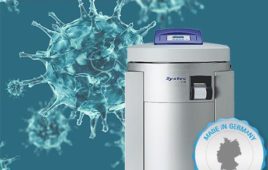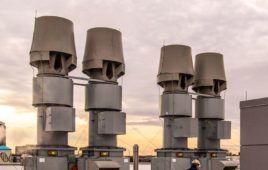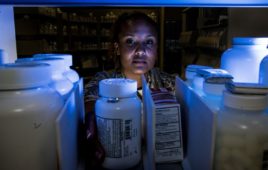Cleanrooms and their contents are the most important components of life science manufacturing facilities. Companies take extreme measures to protect the integrity of their pristine environments and dedicate countless resources on cleanroom design, filtration systems, cleaning procedures, garments and commodities, measuring mechanisms, and corrective actions. There have been many improvements to all of the aspects that make and keep a cleanroom clean — except one. Insulation materials have lagged behind and remained at status quo in the life sciences industry that normally thrives on innovation.
UNMET NEEDS
The need for a proper insulation inside cleanrooms remained unanswered fordecades. Ideally, cleanroom insulation should:
- Have proper thermal conductivity
- Possess very low flame spread and smoke generation qualities
- Accommodate both steam and chill lines
- Be waterproof
- Withstand chemicals used in cleaning
- Not generate particulates
- Recover after impact
- Be easy to install and remove
- Take up little space
Traditional materials satisfy some of the required criteria but fall short of others. Open cell and fibrous insulation products that come with jacketing fail shortly after installation as rigid, thin covers cave and crack upon impact. Unless treated rapidly, contamination, mold growth, and injury to personnel become possibilities. Existing closed-cell materials that can recover after impact have too low of a tolerance for elevated temperatures. Wash-downs and commonly used cleaning chemicals usually render them unusable quickly.
THE PUSH FOR CHANGE
Development of the next generation of cleanroom insulation came from a push from industry. Looking to abandon fibrous and open-cell materials in a new biotech cleanroom project, a major engineering firm, along with the owner, looked for a foam and plastic converter to develop and manufacture the cleanroom insulation to meet stringent requirements.
As a result, the introduction in 2006 of PVDF foams to the life sciences industry lead to long overdue improvements in cleanroom insulation applications. Carrying all the strengths and purity of the resin, these foams meet cleanroom insulation material requirements. They don’t require jacketing and have a temperature range of +155 °C to -50 °C. With a wall thickness of only ¼”, they save space and allow for insulating areas that cannot be covered using existing methods. Installation is easy and fast with custom molded fittings and an overlapping self-adhering tape. They possess excellent moisture, chemical, and UV resistance along with low smoke, flame, and toxicity properties. Their fine closed-cell nature allows for cutting and installing in clean environments without the use of bags or hoods.
SUITABILITY OF NEW INSULATION TO THE CLEANROOM ENVIRONMENT
The natural strength of PVDF resin makes it an excellent fit for cleanrooms.
Among the most significant characteristics of PVDF are that it is:
- Resilient against most chemicals
- Inherently fire retardant
- Resistant to UV and gamma radiation
Preserving PVDF’s robust qualities (Table 1) and purity intact during foaming process is the most crucial aspect in the creation of the new foam. Instead of chemical agents turning plastics into foam, the new insulation system first forces nitrogen under high pressure and temperature into the PVDF, then exhausts it at a lower pressure cycle. The resulting PVDF foam contains no additional chemicals and is as resilient and pure as the resin that went in the process. Figure 1 summarizes the foamingprocedure.


IMPACT OF PVDF FOAM INSULATION IN CLEANROOMS
Space Savings: Hard to reach areas on equipment are now much more accessible. Companies can insulate lines that went uncovered due to space limitations, preventing personnel harm and conserving energy. Designers and manufacturers are developing smaller process equipment with thinner insulation in mind. Especiallysmaller suites have more usable space.
Durability: Insulation lasts longer due to the recovering nature of foam as it eliminates caving or cracks from accidental impacts. And there is no threat ofmoisture penetrating the insulation as PVDF foam insulation will not wick orabsorb moisture.
One Insulation: One material accommodates all piping, including CIP/SIP lines,allowing inventory simplification.
Reduced Labor: PVDF foam insulation’s fine cell structure doesn’t create dust when cut. This reduces installation time by half as installers cut, modify, and install insulation on-site in clean environments without bags or tents, easing schedule pressures and creating significant labor cost reductions.
Fire Safety: In case of a fire, contents of the cleanroom are protected from damage or contamination that can be created by traditional insulation materials. PVDF foam insulation is pure, inherently fire retardant, and possesses a very low flame/smoke rating.
Cleanability: PVDF foam insulation tolerates a wider range of cleaning agents without the fear of damage — it is stable in contact with chemicals with pH levels up to 12.
Particulate Contamination: Technicians can open and reseal PVDF foam insulation to inspect the stainless tubing — unlike traditional insulation. Very fine and closed nature of cells do not shed or break apart when sliced.
SUMMARY
There is a safe alternative to fibrous and open cell materials used in cleanroom insulation. PVDF-based foams’ inherent fire retardance, durability, high temperature ceiling, chemical resistance, and low profiles make them ideal for their intended environment. Their reduced labor and overall ownershipcosts also make them cost-effective.
Tuna Sava is a product manager with UFP Technologies managing product development, expansion, extension, and marketing. He earned a Bachelor of Science in business from the University of Alabama. He can be reached at 978-234-0913; [email protected].



